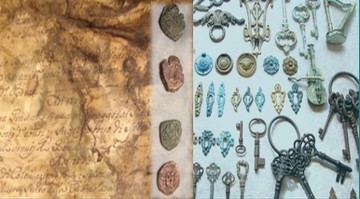As a viewer one is quickly drawn into Mette Glassy `s historical universe, when facing her paintings. As an artist, she works with so many different materials as possible and with as many arts as possible.There is no doubt that it is the Renaissance and the historical Rome, which inspires, because the images are characterized by architectural outline and historical relics. When you look at the pictures more symbols and details appears after some time, and you can see a line between content and expression.The relations between verdigris tones, the copper wire movements and the composition of the pictures make sense of the underlying texts hiding in the pictures in the form of copper-colored sheet of music, Latin prescriptions and titles.

As Mette Glassy chooses to name some of her paintings for rebirth, it gives a direct reference to the Renaissance. The Renaissance, which ran from 1400-1600 century, originated in Italy and literally means rebirth. This refers to a revival of ancient values: art, architecture, literature and philosophy. The period was a time of change, inventions time and multi-artist time and really an inspiration time.
As Mette Glassy combines the various art forms like music, literature, architecture and painting, she works as a true renaissance artist. She knows how to combine different elements from various art forms in the same work. She pulls this way the sources of inspiration from the Renaissance she wants, and interprets them in our present in the same way as a Renaissance artist would have drawn his inspiration from antiquity and recreated into a new expression of his contemporaries.
It is not just the ideological and the stories from Mette Glassy which are interesting, one can not ignore that the craft is also top notch, when facing the images and seeing how the copper color comes in a 3-dimensional way from the verdigris background and plays in the glow of light.The paintings come out of our historical context of contemporary art, since they do not want a confrontation or showdown with former artistic periods which otherwise so often experienced in art history. In conrast, it is expression of a positive historical dialogue that starts a curiosity about the past greatness of times.
Nina Langfeldt Mikkelsen, Art Historian